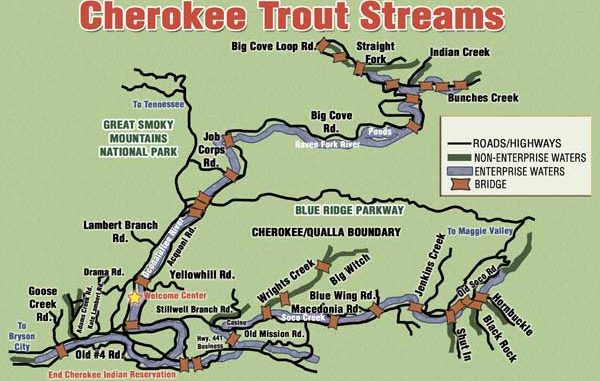
When opening day arrives at Cherokee, even a blizzard can’t hold anglers at bay.
He wasn’t looking forward to a six-hour drive through the mountains on slippery, snow-covered roads, but Bryan Shilbett is a dedicated trout fisherman who never fails to show up for opening day of Cherokee’s pay-to-fish trout season.
When Shilbett left his Randleman home, a light rain was falling. But on his way across Black Mountain, snow was in the air and coated Interstate 40. Shilbett was worn out when he arrived in Cherokee and parked across the street from the Oconaluftee River island park.
But he wasn’t too tired to fish.
He slipped on a pair of waders and a heavily-lined, water-proof coat before grabbing his spinning rod and heading for a river foot bridge. It was terribly cold; the thermometer showed 25 degrees, and Shilbett wondered how low the wind chill had plummeted.
But he was confident of catching a limit of trout because he knew where the fish likely would be hidden in the long run below the bridge. After all, this spot had never failed him in the past.
Snow still was falling when he crossed the bridge, and about 4 inches of the frozen precipitation coated the ground as he approached the river from the gently sloping south side.
Shilbett noticed five other anglers already standing in the 4-foot-deep water at the edge of the swift run where he wanted to fish, but there was room for him at the lower end of the fishing queue.
A piercing beam of sunlight broke through a hole in the dark clouds as Shilbett removed a 1/8-ounce yellow Panther Martin in-line spinner with black spots on the blade from his lure box. He connected it to the snap swivel at the end of his monofilament line before returning the lure box to a large coat pocket.
Shilbett waded downstream a short distance then to downstream about 25-feet from the nearest angler. His cast dropped his lure into the clear, fast water near the other bank. He closed the bail on his reel as the spinner approached the bottom.
As soon as he started his retrieve, a 17-inch rainbow trout immediately struck the lure, hooking itself and jerking line from the spool as it swam downriver.
The trout didn’t leap out of the water, but it put a large bend in Shilbett’s 6-foot rod. A few minutes later, he netted the fish and hooked it on his stringer. During the next 30 minutes, he caught six more rainbows, ranging in size from 9 to 15 inches, while using the same lure.
Shilbett, only three fish shy of a 10-fish limit, decided to wade ashore and take a break. He met David Ensley, then manager of Fish & Game Management for the Eastern Band of the Cherokee Nation, who introduced himself and congratulated Shilbett on his catch.
Ensley retired during January 2007 after 32 years of service to the tribe, the last 12 as the Cherokee’s fish and game manager.
“That’s a very nice catch of trout,” Ensley said. “How long did it take you to catch them?”
“Slightly less than an hour,” Shilbett said.
“Chief, come over here and take a look at this fellow’s trout,” Ensley said.
Michell Hicks, chief of the Eastern Cherokees, was drifting a gob of paste-trout bait through the upper shallower section of the run but hadn’t had a bite. He was ready to take a break and wanted his son, Noah, to see the trout. Noah Hicks wasn’t fishing, just watching his dad and others try their luck.
“Wow,” the youngster said.
After drinking some coffee, Shilbett waded back to his fishing spot and caught his final three trout.
Two fly fishermen cast nymphs into shallow runs above the foot bridge, but they didn’t appear to be having much success.
Farther north on the river, single fishermen and small groups of two or three lined the Oconaluftee River to where the Raven Fork entered and beyond. Some of them reeled in struggling fish while others added trout to their stringers.
Obviously, plenty of trout were in the river, ready to be caught. Ensley said 13,000 pounds of brook, rainbow and brown trout had been released into waters open to public fishing during the preceding week.
At what some anglers call Raven Fork’s “bend in the river pool,” three bait anglers fished both sides of the pool. One adult angler, fishing from the bank next to the road, said he had driven from Little Rock, Ark., to spend three days at Cherokee. He fished during the day and played the slot machines at Harrah’s Casino at night.
He held up a stringer that contained a brown trout that pushed 5 pounds and four rainbows 10 to 15 inches in length. His trout had struck small night crawlers (worms), he said.
When the Arkansan finished talking, three young anglers on the west bank displayed their stringers of 10- to 16-inch fish. Two of them were near their limit, and the third angler had landed five fish. Even though the youngsters appeared to be shivering in the cold air, they appeared to be enjoying their outing.
“We’ve never caught so many trout so quickly,” said the eldest, “and we get to fish here often since we live only a few miles from Cherokee.“
At the first bridge across the Raven Fork, anglers lined the banks at least to the bend in the river.
One angler, fishing just below the bridge with a telescopic spinning rod, netted a nice trout, and his partner was adding what appeared to be a 10- to 12-inch rainbow to his stringer.
“The cold air and snow wouldn’t be so bad if ice didn’t freeze in the guides and interfere with our casting,” said the angler with the stringer as he stood next to a snow drift.
At a sharp curve in the blacktop, just beyond a convenience store, passersby could see a father and son fishing. The boy, who couldn’t be more than six-years-old, had a fish on and was excited.
“Dad, get the net before this fish gets away,” he said, yelling as he stood in water almost to the top of his hip boots.
But his father, standing just back of him in shallow water, already had a net in hand. Seconds later he held up a shiny, 9-inch rainbow for his proud son to see.
“Boy, this is cool,” said the boy, as his father smiled.
At a flat section of the river, two fly fishermen drifted nymphs through shallow runs. Each had a small stringer of trout trailing behind him in the clear water, but no fish was longer than 12 inches.
“We haven’t hooked or seen a large trout this morning, but I know that a lot of trout over 15 inches were released in Raven Fork yesterday,” one fly angler said. “Looks like the bait fishermen are catching the larger trout today.“
Not all fly fishermen are purist, but all purists insist on using only hand-tied, artificial flies. No other group of anglers enjoys fishing more than they. An angler has to have a well-developed sense of feel and possess quick reflexes to hook a trout mouthing a nymph.
This section of Raven Fork, considered by many observers to offer the most scenic stream views in the Smokies, is downstream from the juncture of Raven Fork and Straight Fork rivers. During opening day of 2006, the addition of a heavy snow fall made the creek area even prettier.
But the anglers lining the sides of Raven Fork weren’t there primarily to enjoy the beauty. Trout catching was their game, and some of them were quite successful.
There was scarcely room to stand at the pools and runs, but the trout were biting, so no one was complaining loudly about the crowded conditions.
The water probably had never been clearer, and if 90 percent of the fishermen hadn’t been using worms, paste bait or eggs, the catch rate likely would have suffered. But most of the trout had been hatched and raised in the Straight Fork hatchery. Accustomed to being fed each morning on a regular basis, the fish were hungry and many of them would be caught that weekend and replaced by new stockings the following week.
One angler working the hole just below the bridge was casting an in-line Mepps spinner, and the ¼-ounce Black Fury lure had been receiving hits all morning. He had nine trout on his stringer, floating in the shallow water next to the rocky bank. None was shorter than 10 inches, and three were longer than 15 inches — sizes almost never seen in the trout streams of the nearby Great Smoky Mountains National Park.
“It’s been a terrific morning to fish,” said Billy Harnett of Spartanburg, S.C. “I haven’t missed many opening days in the past 10 years, and the fishing today is as good as it gets. I think the cold has sharpened the hunger of the trout. Most of the hits have been really hard, and the fish has fought all the way to the net. After I catch one more fish, I’m going back to my room, clean up, change clothes and eat lunch, Then I’m going to play the slot machines at the casino. Wish me luck.”
Anglers fishing these holes and runs had varying quantities of trout on their stringers, and none of these fishermen had a frown on his face.
A short section of Raven Fork above the bridge is open to public fishing, but Straight Fork River from Raven Fork to just past the hatchery is off limits to non-Cherokees. Beyond the hatchery is U. S. Forest Service land, and that section of the river is a creek containing mostly small native brook trout.
If the hatchery gate is open, Charlie Toinetta, hatchery manager, often gives visitors a tour of the facility. Most of the runways will be full of trout, and he’s particularly proud of the 3- to 7-pounders the Cherokees release each week.
To raise money needed to help support tribal operations, the Eastern Band of the Cherokees decided in 1964 to obtain trout from nearby state and federal hatcheries and stock them in their streams so they could sell permits to outsiders wanting to fish at the reservation.
Waters open to public fishing are designated Enterprise Waters. Included is Raven Fork from just above the bridge where Straight Fork River enters downstream to the Oconaluftee River; the Oconaluftee River from the northern reservation boundary to its southern boundary at Birdtown; Bunches Creek; the three ponds at Big Cove; and Soco Creek along U. S. 19 East. Non-Enterprise waters only may be fished by registered Cherokees.
In 1986 the Cherokees completed their trout hatchery at Straight Fork River and started hatching trout eggs obtained from state and federal hatcheries. Brook trout eggs arrived from Utah, while rainbow and brown trout eggs came from a variety of hatcheries.
The following rules were established for guests to follow:
• The daily creel and possession limit is 10 trout of any size.
• Except for Big Cove Ponds, caught trout may be kept or released. Pond trout must be kept.
• Enterprise Waters are open to public fishing seven days a week during the open season starting one-half hour before sunrise and ending one-half hour after sunset.
• Only Enterprise Waters are open to public fishing. All other streams on the reservation are designed non-enterprise waters and only registered tribal members may fish them.
• The open season for Enterprise Waters extends from the last Saturday in March through the last day in the following February.
• Fish may be taken using only one rod and line with bait or lure.
• All fishing guests must possess a valid tribal fishing permit, which are sold by the Cherokee Fish & Game Division and by many cooperating businesses. Permit costs are: $7 for one day, $14 for two days; $20 for three days, $28 for five days, and $200 for the season.
• Children under the age of 12 may fish free of charge when accompanied by a parent or guardian with a valid permit.
These regulations are vigorously enforced.
Ensley said during that opening day a few anglers were charged with possessing too many trout. They were fined $50 per person for exceeding the daily limit and charged $20 for each fish they had in excess of the permitted 10. Their catches were confiscated.

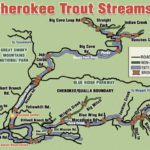
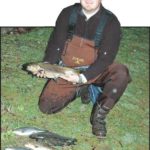
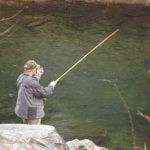
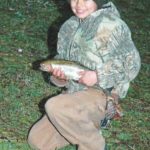
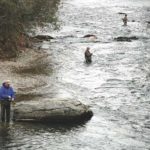
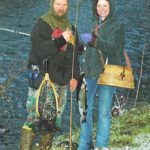
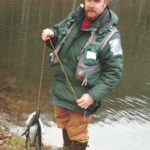


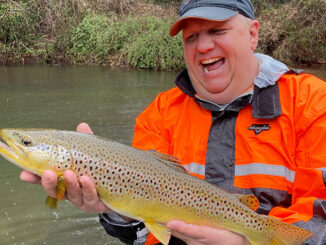
Be the first to comment